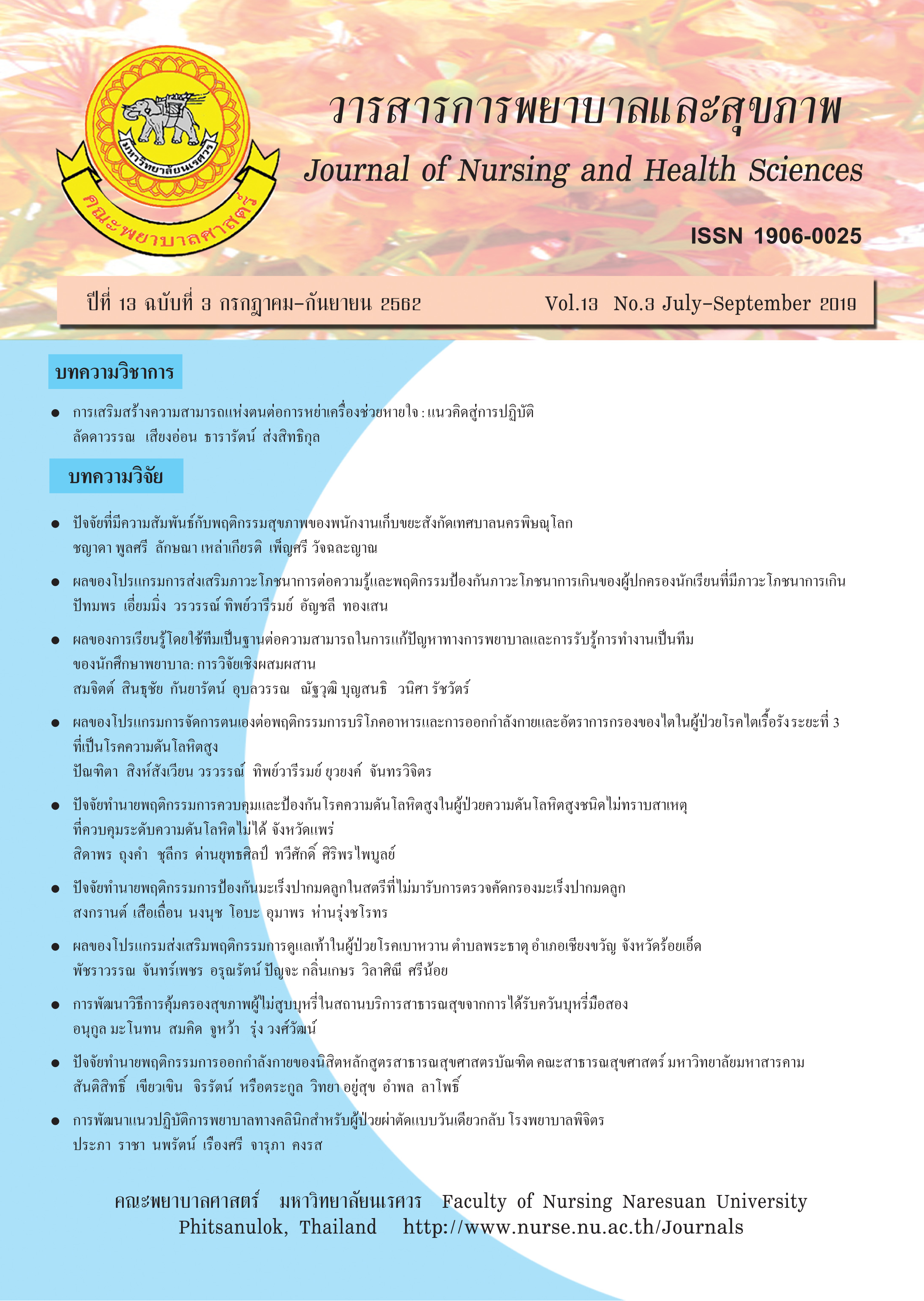Effects of Foot Care Behaviors Promoting Program among Diabetic Patients in Phra That Sub-district, Chiang Khwan District, Roi Et Province
Main Article Content
Abstract
This study was the Quasi-Experimental Research, which was one group pretest-posttest design, aimed to study the effects of foot care behaviors promoting program among 41 persons of diabetic patients, who received health service of Phra That Tambon Health Promoting Hospitals in Chiang Khwan district, Roi-Et province. The samples were selected by purposive sampling, according to specified criteria and received the foot care behaviors promoting program which applied from the concept of self-efficacy and social support for 12 weeks. Data were collected by using questionnaires with 0.85 of content validity index and 0.83 of reliability. Descriptive statistic had been used frequency, percentage, mean and standard deviation. Comparative analysis were used Paired Sample t-test at 0.05 level of significant.
After the implementation, the results found that the diabetic patients had higher mean score of knowledge about foot care, self-efficacy of foot care and foot care behaviors than before the intervention with statistically significant (p-value < 0.001)
Conclusion and recommendation: This foot care promoting program could effect to the knowledge about foot care, self-efficacy of foot care and foot care behaviors in diabetic patients. It should be proceeded continuously to prevent foot complications in the long term and should be applied for the diabetic patients in other areas which a similar contexts.
Article Details
References
American Diabetes Association. (2003). Preventive foot care in people with diabetes. Diabetes Care, 26(suppl 1), s78-s79.
Beiranvand, S., Fayazi, S., & Asadizaker, M. (2015). Effect of educational programs on the knowledge, attitude, and practice of foot care in patients with diabetes. Jundishapur Journal of Chronic Disease Care, 4(2), 103-111.
Bureau of Non Communicable Diseases. (2018). Annual report 2017 the bureau of non-communicable diseases, Department of Disease Control, Ministry of Public Health. Retrieved 10 January 2018 from http://www.thaincd.nnual2017_Report.pdf. [In Thai].
Chiang Khwan Hospital. (2018). Diabetes patients in Chiang Khwan district report. HOSxP database. Roi Et: Chiang Khwan Hospital. [In Thai].
Chuepan, S. (2016). Impact of an integrative podiatric care programme on foot-care behaviour, foot conditions and the HbA1c level in diabetes patients with high susceptibility to foot wounds. Thai Journal of Nursing Council, 31(1), 111-123. [In Thai].
Chusak, T., Sasang, N., & Chaleoykitti, S. (2018). Effect of diabetes foot care program to prevent leg cramps of type 2 diabetic patients, Samrongchai sub-district,Phisalee district, Nakhon Sawan province. Royal Thai Army Medical Journal, 71(2), 105-112. [In Thai].
Department of Environmental Quality Promotion, Ministry of Natural Resources and Environment. (2017). World Population Day 2017. Retrieved 3 January 2018 from http://www.deqp.go.th/service-portal/news-system/news-detail/?id=201898. [In Thai].
Diabetes Association of Thailand. (2012). Diabetes clinical practice guideline 2011. Bangkok: Srimuang. [In Thai].
Fendy, S., Junprasert, S., & Leelukkanaveera, Y. (2013). The effects of self-efficacy development and social support for foot care behavior and foot health among type 2 diabetes patients. The Journal of Faculty of Nursing Burapha University, 21(4), 49-61. [In Thai].
Googridge, D., Trepman, E., & Embil, J.M. (2005). Health-related quality of life in diabetic patients with foot ulcers: literature review. Wound Ostomy Continence Nurse, 32(6), 368-77.
Mahdalena & Ningsih, P.E.S. (2016). Effectivity of foot care education program in improving knowledge, self-efficacy and foot care behavior among diabetes mellitus patients in Banjarbaru, Indonesia. National Public Health Journal, 11(2), 56-60.
Mohamed H.A., Elsaher H.E., Aref M.S. & Fouad N. (2015). The effect of diabetic foot care training program on elderly adults' outcome. Journal of Nursing and Health Science, 4(4), 14-20.
Phanphuech, P. (2012). Effects of the self-efficacy and social support enhancement program on foot care behavior among the elderly with diabetes mellitus. Master Thesis (Gerontological Nursing), Burapha University, Chonburi. [In Thai].
Phra That Tambon Health Promoting Hospitals. (2018). Wound care service data report. HOSxP database. Roi Et: Phra That Tambon Health Promoting Hospitals. [In Thai].
Phra That Tambon Health Promoting Hospitals. (2018). Diabetes patients data report. HOSxP database. Roi Et: Phra That Tambon Health Promoting Hospitals. [In Thai].
Phuwong, Y., & Pinitsoontorn, S. (2014). Complication among diabetes patients in a selected community hospital in the northeast. Community Health Development Quarterly Khon Kaen University, 2(3), 311-319. [In Thai].
Polit, D.F. & Hungler, B.P. (1995). Nursing research: principles and methods (5th ed.). Philadelphia: J. B. Lippincott company.
Ratanapokapan, I. (2017). The effects of foot care promoting program on self-efficacy and foot care behaviors among diabetic patients at risk of foot ulcers. Retrieved 3 January 2018 from http://www.sangkhahospital.com/ sangkha/administrator/modules/mod_download/img/3_261_11_08_2017_16_17_13_IssarapornRattanapokphun.pdf. [In Thai].
Roi Et Hospital. (2018). Diabetes patients in Roi Et province report. HOSxP database. Roi Et: Roi Et Hospital. [In Thai].
Sharoni, S.K.A., Rahman, A.H., Minhat, H.S., Ghazali, S., & Ong, M.H. (2017). A self-efficacy education programme on foot self-care behaviour among older patients with diabetes in a public long-term care institution, Malaysia: a Quasi-experimental Pilot Study. British Medical Journal, 7(3), 139-150.
Sota, C. (2011). Concepts theories and application for health behavioral development. Faculty of Public Health, Khon Kaen University: Khon Kaen. [In Thai].
Srisuanjik, R., & Piyawattanapong, S. (2014). Effect of perceived self-efficacy and family Support enhancement program on foot care behaviors among diabetes mellitus type 2 older persons at high risk for diabetic foot ulcers. Journal of Nursing and Health Care, 32(1), 105-114. [In Thai].
Suwannakin, A. (2016). Nursing care for foot care to prevent ulcer in diabetic persons. Retrieved 5 January 2018 from https://www2.si.mahidol.ac.th/division/nursing/sins/attachments/article/251/sins_nursing_manual_2560_11. pdf. [In Thai].
The Royal College of Physicians of Thailand & Diabetes Association of Thailand. (2017). Clinical practice guideline for diabetes 2017. Retrieved 5 January 2018 from https://www.dmthai.org/attachments/article/443/25610702_ guideline-diabetes-care-2017.pdf. [In Thai].
Trakulkarn, A. (2011). Effect of foot care program to foot care knowledge and behavior of older persons with diabetes mellitus type 2. Independent Study Report for the Master of Nursing (gerontological nursing). Master Thesis, Khon Kaen University, Khon Kaen. [In Thai].


